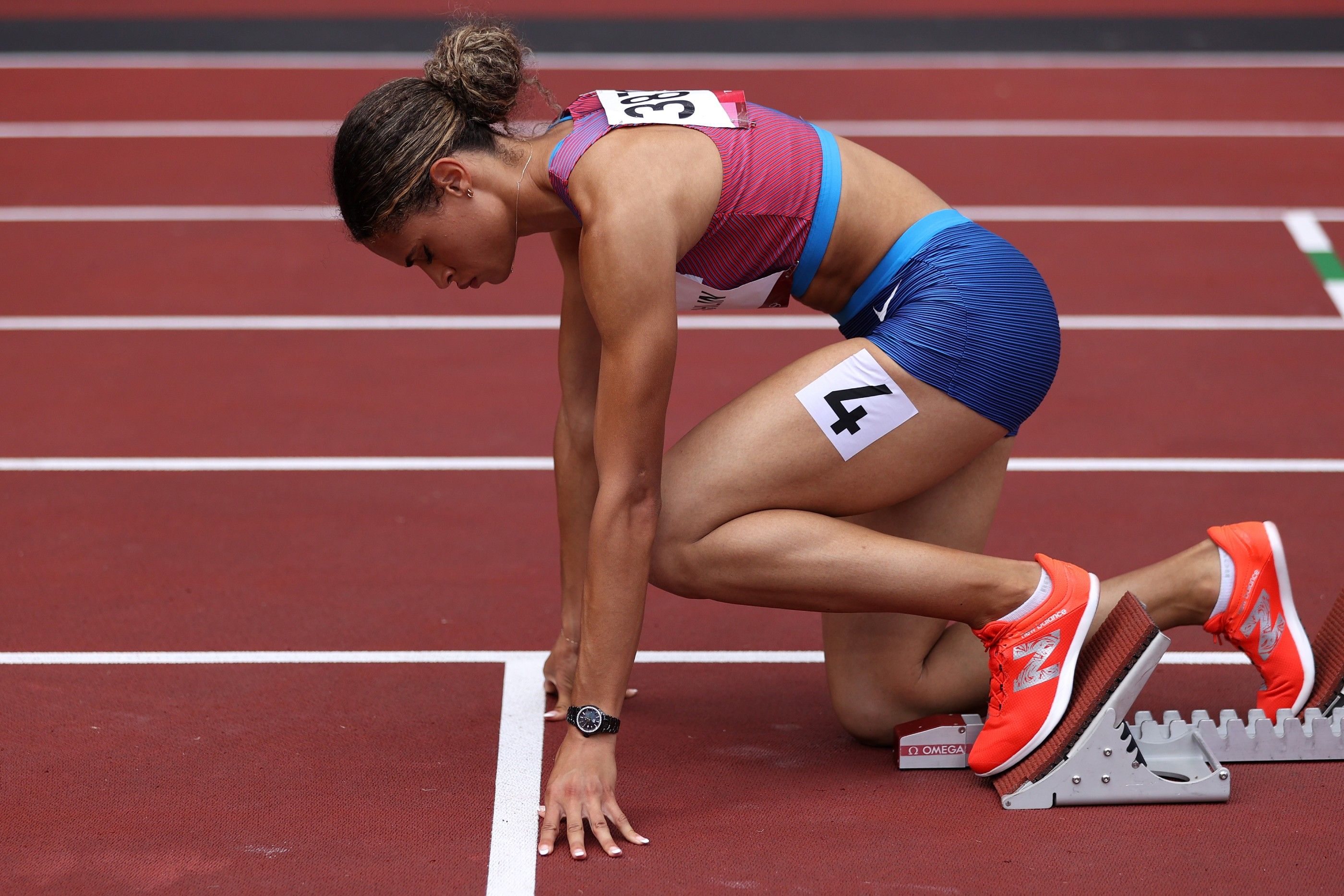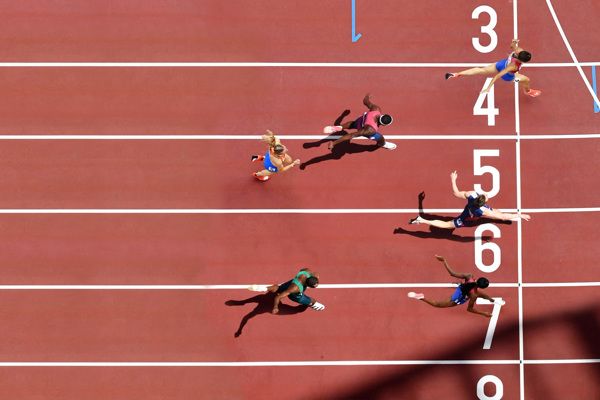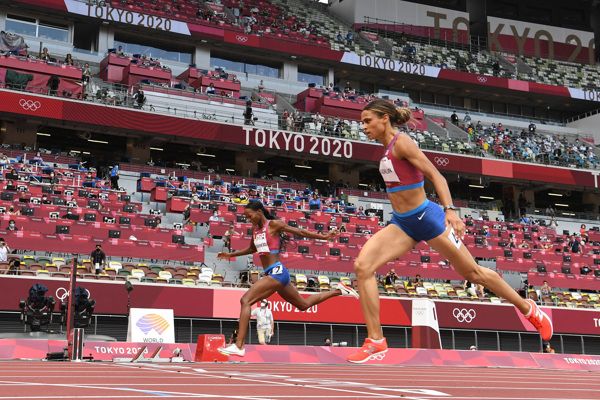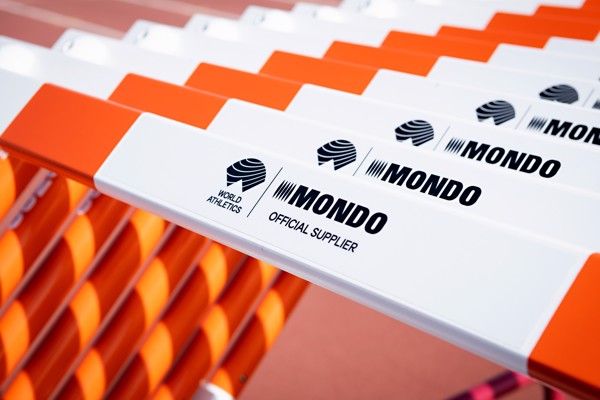The Olympic men's 400m hurdles final on the Mondo WS-TY4 track in Tokyo (© Getty Images)
“That track is crazy,” said Karsten Warholm.
“You can feel the bounce,” said Sydney McLaughlin.
“It’s a phenomenal track,” said Rai Benjamin.
“I can feel that energy return,” said Dalilah Muhammad.
No matter which way you turned in Tokyo, the reaction from athletes seemed to be the same: the Mondo WS-TY4 surface in the Olympic Stadium was the quickest they’d ever encountered.
That TY on the end of its name? It stands for Tokyo, and how the Mondo WS surface that was in place in Rio’s Olympic Stadium has evolved since to become better and faster, but we’ll get to the specifics in a moment.
Before we do, it’s worth noting that not every event produced the earth-shattering times run by the above quartet, with many events there broadly in line with previous championships. As such, the suggestion the track surface is the sole or even primary reason for those 400m hurdles times seems unfair to what is – quite clearly – the most gifted generation to have graced the event.
But at the same time, this new surface certainly didn’t do them any harm, and likely offered some level of time saving. The exact amount? We’ll never truly know.

Track surfaces, much like footwear, are in a constant state of evolution. In the 1800s most athletics events were staged on grass, dirt or cinder, with synthetic surfaces made from a combination of asphalt or rubber first introduced in the 1950s.
In the 1960s the first polyurethane track surfaces were created, with the 1968 Mexico Olympics the first Games to feature a firm synthetic surface. In 1969, Mondo introduced the first pre-manufactured vulcanised natural rubber track, and the company supplied the official track for the 1976 Montreal Games. It’s been the supplier of the track for every Olympics since, with the vast majority of four-year cycles seeing some form of tweaking to help the world’s best athletes shave off fractions of a second.
The track we were all riveted to in Tokyo? It took three years of design, research and development before coming to fruition. The process began in 2017, with various compositions tried and tested before Mondo settled on this one.
“We have developed a pre-fabricated material, made in rubber and rolls, the same technology we use in Formula One car tyres,” says Andrea Vallauri, international relations manager for Mondo. “The difference is we make sheets. It’s composed of two layers that are vulcanised together and we can adjust the characteristics so it performs as best we can.
“The lower part is made with honeycomb cells that have inside some air, so when the athletes press their feet on the track this lower part of the surface is compressing the air. This provides exceptional shock absorption but at the same time this material provides push-back: a spring or trampoline effect.
“On the top part we have developed special three-dimensional micro-granules of rubber that we call TY: these have specific characteristics that are vulcanised together with the rest of the material and this shows reactivity, or push. With the combination of the two, we think we have reached an ideal combination where the structure provides good absorption, cushioning, to the athletes but at the same time a very good push and spring when they run.”
The key part of the process was testing. The biomechanics of the track were tested in an Asics research laboratory which found it delivered better performance than previous versions. The key finding? The impulses of propulsion force were the same, but propulsion time (and total contact time) of WS-TY was shorter.
“The granules ensure an optimised and uniform dynamic elastic response to the athletics track to help athletes maintain control over stride length, running pace and balance, essential for boosting speed and better reaching the correct take-off point in front of obstacles and before a jump,” says Vallauri.
Speaking to athletes in Tokyo appeared to bear out that claim.
“It truly felt fast,” said Muhammad, who ran 51.58 to win silver behind McLaughlin. “As a 400m hurdler you can kind of tell how fast the track is, how easily you’re making your steps in between the hurdles and it was spot on every single hurdle so I’m like, ‘wow, this is a fast track.’ I was able to do a 14-step pattern.
“I can feel that energy return, especially when you go into (hurdle) eight and feel that death; I didn’t feel like I was going into death.”
McLaughlin, who smashed her own world record with 51.46, was in agreement.
“Some tracks just absorb your bounce and your motion; this one regenerates it and gives it back to you,” she said. “I would say it’s a pretty fast track. You can feel a little bit of difference.”

The track that currently sits in the Olympic Stadium was produced in May and June of 2019 and installed over a four-month period between August and November that year. Before agreeing on the exact composition for the Tokyo Games, Mondo had samples sent to Italy, USA and Spain so athletes could test various models, unaware which one was the new version.
“We had samples A, B and C,” says Vallauri. “The response from all these athletes was the same: the new product we were developing was for them the most comfortable and performing. They did not know which one it was and this gave us a certain confidence that we were on the right way.”
The track is 13mm thick and its designers believe it can provide a performance benefit of up to 1-2%. Its first try in competition came in December 2019 when it was tested and certified by the Japanese Athletics Federation and World Athletics. Of course, most international athletes only got the chance to try it at the Olympics themselves, but multiple athletes reported this week it felt more cushioned than previous versions.
“It's really soft,” said Benjamin, shortly after clocking 46.17 to finish second in the 400m hurdles. “It does give a lot of advantages.”
After his world record of 45.94, Warholm was asked about the surface and whether – as another athletes suggested – it was like running on air.
“I never ran on air,” he laughed. “But I think actually air isn't that, you know, bouncy. But that track is crazy. It actually gave me London vibes – the place where I got my first gold medal – and it's a very fast track. But I think it's not just the track; it was the guys as well today.”
In the discussion around advancing technology, it was an important point from the current king of the 400m hurdles.
This track will remain in situ in Tokyo’s Olympic Stadium , but when the attention starts to turn to the Paris Olympics, will there be something new in the works for that?
“For sure,” says Vallauri. “Research will never stop. We have in mind some things, but it takes time.”
Cathal Dennehy for World Athletics








